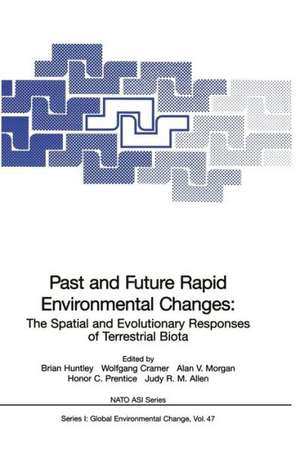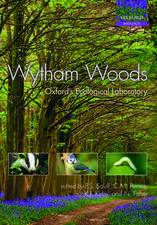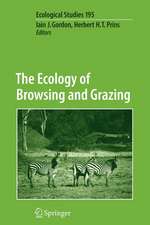Past and Future Rapid Environmental Changes: The Spatial and Evolutionary Responses of Terrestrial Biota: Nato ASI Subseries I:, cartea 47
Editat de Brian Huntley, Wolfgang Cramer, Alan V. Morgan, Honor C. Prentice, Judy R.M. Allenen Limba Engleză Paperback – 27 sep 2011
Din seria Nato ASI Subseries I:
- 15%
 Preț: 641.85 lei
Preț: 641.85 lei - 15%
 Preț: 649.87 lei
Preț: 649.87 lei - 15%
 Preț: 659.70 lei
Preț: 659.70 lei - 18%
 Preț: 957.75 lei
Preț: 957.75 lei - 18%
 Preț: 941.05 lei
Preț: 941.05 lei - 18%
 Preț: 959.36 lei
Preț: 959.36 lei - 15%
 Preț: 664.93 lei
Preț: 664.93 lei - 15%
 Preț: 655.27 lei
Preț: 655.27 lei - 15%
 Preț: 644.49 lei
Preț: 644.49 lei - 15%
 Preț: 639.08 lei
Preț: 639.08 lei - 18%
 Preț: 951.29 lei
Preț: 951.29 lei - 18%
 Preț: 952.57 lei
Preț: 952.57 lei - 15%
 Preț: 653.33 lei
Preț: 653.33 lei - 18%
 Preț: 958.56 lei
Preț: 958.56 lei - 15%
 Preț: 641.85 lei
Preț: 641.85 lei - 15%
 Preț: 650.86 lei
Preț: 650.86 lei - 18%
 Preț: 957.94 lei
Preț: 957.94 lei - 15%
 Preț: 649.54 lei
Preț: 649.54 lei - 15%
 Preț: 646.30 lei
Preț: 646.30 lei - 15%
 Preț: 648.89 lei
Preț: 648.89 lei - 15%
 Preț: 640.06 lei
Preț: 640.06 lei - 18%
 Preț: 950.21 lei
Preț: 950.21 lei - 15%
 Preț: 643.65 lei
Preț: 643.65 lei - 15%
 Preț: 649.54 lei
Preț: 649.54 lei - 15%
 Preț: 649.54 lei
Preț: 649.54 lei - 15%
 Preț: 641.71 lei
Preț: 641.71 lei - 15%
 Preț: 642.83 lei
Preț: 642.83 lei - 15%
 Preț: 639.59 lei
Preț: 639.59 lei - 15%
 Preț: 646.62 lei
Preț: 646.62 lei - 18%
 Preț: 962.49 lei
Preț: 962.49 lei - 15%
 Preț: 647.73 lei
Preț: 647.73 lei - 15%
 Preț: 641.71 lei
Preț: 641.71 lei - 18%
 Preț: 1231.47 lei
Preț: 1231.47 lei - 15%
 Preț: 649.22 lei
Preț: 649.22 lei - 15%
 Preț: 658.70 lei
Preț: 658.70 lei - 15%
 Preț: 641.71 lei
Preț: 641.71 lei - 15%
 Preț: 659.85 lei
Preț: 659.85 lei - 18%
 Preț: 1832.08 lei
Preț: 1832.08 lei - 18%
 Preț: 965.02 lei
Preț: 965.02 lei - 18%
 Preț: 955.25 lei
Preț: 955.25 lei - 15%
 Preț: 650.55 lei
Preț: 650.55 lei - 18%
 Preț: 965.97 lei
Preț: 965.97 lei - 15%
 Preț: 652.64 lei
Preț: 652.64 lei - 15%
 Preț: 646.43 lei
Preț: 646.43 lei - 18%
 Preț: 1832.08 lei
Preț: 1832.08 lei - 18%
 Preț: 1225.62 lei
Preț: 1225.62 lei
Preț: 956.33 lei
Preț vechi: 1166.26 lei
-18% Nou
Puncte Express: 1434
Preț estimativ în valută:
183.01€ • 198.73$ • 153.73£
183.01€ • 198.73$ • 153.73£
Carte tipărită la comandă
Livrare economică 22 aprilie-06 mai
Preluare comenzi: 021 569.72.76
Specificații
ISBN-13: 9783642644719
ISBN-10: 3642644716
Pagini: 548
Ilustrații: XVI, 523 p.
Dimensiuni: 155 x 235 x 29 mm
Greutate: 0.76 kg
Ediția:Softcover reprint of the original 1st ed. 1997
Editura: Springer Berlin, Heidelberg
Colecția Springer
Seria Nato ASI Subseries I:
Locul publicării:Berlin, Heidelberg, Germany
ISBN-10: 3642644716
Pagini: 548
Ilustrații: XVI, 523 p.
Dimensiuni: 155 x 235 x 29 mm
Greutate: 0.76 kg
Ediția:Softcover reprint of the original 1st ed. 1997
Editura: Springer Berlin, Heidelberg
Colecția Springer
Seria Nato ASI Subseries I:
Locul publicării:Berlin, Heidelberg, Germany
Public țintă
ResearchCuprins
Section 1 — Past environmental changes — the late Quaternary.- Past environmental changes: Characteristic features of Quaternary climate variations.- Modelling late-Quaternary palaeoclimates and palaeobiomes.- Section 2 — Spatial responses to past changes.- Spatial response of plant taxa to climate change: A palaeoecological perspective.- The response of New Zealand forest diversity to Quaternary climates.- Character of rapid vegetation and climate change during the late-glacial in southernmost South America.- Holocene tree migration rates objectively determined from fossil pollen data.- Flora and vegetation of the Quaternary temperate stages of NW Europe: Evidence for large-scale range changes.- The response of beetles to Quaternary climate changes.- Fossil Coleoptera assemblages in the Great Lakes region of North America: Past changes and future prospects.- The response of Coleoptera to late-Quaternary climate changes: Evidence from north-east France.- The spatial response of mammals to Quaternary climate changes.- The spatial response of non-marine Mollusca to past climate changes.- Section 3 — Mechanisms enabling spatial responses.- Reinterpreting the fossil pollen record of Holocene tree migration.- Mechanisms of vegetation response to climate change.- Plant invasions: Early and continuing expressions of global change.- Invading into an ecologically non-uniform area.- Migratory birds and climate change.- Tree demography and migration: What stand-level measurements can tell about the response of forests to climate change.- Structural changes in the forest-tundra ecotone: A dynamic process.- Modelling the structural response of vegetation to climate change.- Section 4 — Evolutionary responses to past changes.- Species’ habitats in relation to climate,evolution, migration and conservation.- The evolutionary response of vertebrates to Quaternary environmental change.- The weight of internal and external constraints on Pupilla muscorum L. (Gastropoda: Stylommatophora) during the Quaternary in Europe.- Late Quaternary extinction of large mammals in Northern Eurasia: A new look at the Siberian contribution.- Section 5 — Mechanisms enabling evolutionary responses.- Variation in plant populations: History and chance or ecology and selection?.- Genetics and adaptation to climate change: A case study of trees.- Climate change and the reproductive biology of higher plants.- Space and time as axes in intraspecific phylogeography.- Migratory birds: Simulating adaptation to environmental change.- Terrestrial Invertebrates and climate change: Physiological and life-cycle adaptations.- Section 6 — Predicted future environmental changes and simulated responses.- Forecast changes in the global environment: What they mean in terms of ecosystem responses on different time-scales.- The biogeographic consequences of forecast changes in the global environment: Individual species’ potential range changes.- Gap models, forest dynamics and the response of vegetation to climate change.- Natural migration rates of trees: Global terrestrial carbon cycle implications.- Seasonal features of global net primary productivity models for the terrestrial biosphere.- General discussion and workshop conclusions.- Predicting the response of terrestrial biota to future environmental changes.- List of Workshop Participants.










